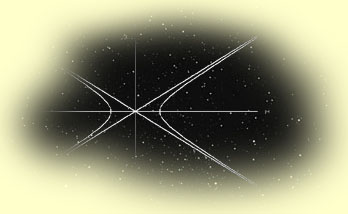
 |
Theory of Tachyons
Faster than Light Propagation |
 It had long been assumed that the theory of relativity has established the speed of light as the highest speed allowed. If this were so, we would never be able to study the contemporary physical conditions beyond our galaxy; and in practice, beyond the solar system. It would be, therefore, desirable to have particles that travel beyond the speed of light. It had long been assumed that the theory of relativity has established the speed of light as the highest speed allowed. If this were so, we would never be able to study the contemporary physical conditions beyond our galaxy; and in practice, beyond the solar system. It would be, therefore, desirable to have particles that travel beyond the speed of light.
In the summer of 1958 when Sudarshan was at the University of Rochester, someone asked him about what happens to energy and momentum when a particle travels faster than light. Sudarshan saw that energy and momentum could be made real by taking rest mass to be imaginary for such particles. The second difficulty of the apparent traveling "backward in time" of such a particle was solved by the interchange of the emission and absorption of the particle.
Along with a graduate student, V. K. Deshpande, Sudarshan wrote a short paper and sent it to Physical Review Letters. It came back from a referee who rejected it, saying it was incorrect. Sudarshan requested a second referee who said that the results of the paper were correct, but it was all well known! A third referee stated that he had "read both the previous referee reports and he agreed with both of them"! About two years later, after Sudarshan joined the University of Rochester faculty, his colleague O.M.P. Bilaniuk offered to rewrite the paper and get it published. He did it and they published it in American Journal of Physics. It attracted a lot of attention and several letters to Physics Today.
To make a quantum theory one had to quantize a scalar field with imaginary mass. Dhar and Sudarshan completed this in the spring of 1968. (By this time Feinberg at Columbia published a paper with all Sudarshan’s results, without acknowledgement to him). Feinberg’s work contained essential inconsistencies, but it supplied the name "tachyon" for these particles. Arons and Sudarshan corrected the mistakes in Feinberg's work and carried out the correct quantization of tachyons.
The quantum theory of tachyons contained the reinterpretation principle; and they could have either spin 0 or "continous spin" and could obey either Bose or Fermi statistics. The quantum field theory leads to a tachyon cloud of virtual particles coupled to a tachyon field. Tachyons could manifest themselves as resonances in momentum transfer in particle collisions. Various other aspects are treated in other papers including many by Recami.
To date, no tachyons have been detected. However, tachyons arise naturally in string theories but are suppressed or ignored. The role of tachyons in cosmology was investigated by Narlikar and Sudarshan. They concluded that any primordial tachyons would have vanished long ago.
|
 | See more detailed
REVIEW and REFERENCES below. |
 |
Schedule of symposium talks for Tachyons. |
 | Next topic overview: VII. Quantum Mechanics of Open Systems
|
| REFERENCES
 "Meta" Relativity; with O. M. P. Bilaniuk and V. K. Deshpande, Amer. J. Phys. 30, 718-723 (1962). "Meta" Relativity; with O. M. P. Bilaniuk and V. K. Deshpande, Amer. J. Phys. 30, 718-723 (1962).
 Lorentz Invariance, Local Field Theory, and Faster than Light Particles; with M. E. Arons, Phys. Rev. 173, 1622 (1968). Lorentz Invariance, Local Field Theory, and Faster than Light Particles; with M. E. Arons, Phys. Rev. 173, 1622 (1968).
 Quantum Field Theory of Interacting Tachyons; with J. Dhar, Phys. Rev. 174, 1808 (1968). Quantum Field Theory of Interacting Tachyons; with J. Dhar, Phys. Rev. 174, 1808 (1968).
 Causality and Spacelike Signals; with O. M. P. Bilaniuk, Nature 223, 386 (1969). Causality and Spacelike Signals; with O. M. P. Bilaniuk, Nature 223, 386 (1969).
 The Nature of Faster than Light Particles and Their Interactions, Arkiv fur Physik 39, 40 (1969). The Nature of Faster than Light Particles and Their Interactions, Arkiv fur Physik 39, 40 (1969).
 Particles Beyond the Light Barrier; with O. M. P. Bilaniuk, Phys. Today 22, 43 (1969). Particles Beyond the Light Barrier; with O. M. P. Bilaniuk, Phys. Today 22, 43 (1969).
 Tachyon Cloud of a Particle, Phys. Rev. D 1, 2428 (1970). Tachyon Cloud of a Particle, Phys. Rev. D 1, 2428 (1970).
 The Theory of Particles Traveling Faster than Light I, Symposia on Theoretical Physics and Mathematics 10 A. Ramakrishnan (ed.), Plenum Press, New York (1970). The Theory of Particles Traveling Faster than Light I, Symposia on Theoretical Physics and Mathematics 10 A. Ramakrishnan (ed.), Plenum Press, New York (1970).
 Tachyons and Cosmology; with J. V. Narlikar, Monthly Notices of Royal Astronomical Society, 175, 105 (1976). Tachyons and Cosmology; with J. V. Narlikar, Monthly Notices of Royal Astronomical Society, 175, 105 (1976).
 Tachyons and the Search for an Absolute Frame. Sent to E. Recami (ed.), Tachyons and Related Topics; North Holland. Tachyons and the Search for an Absolute Frame. Sent to E. Recami (ed.), Tachyons and Related Topics; North Holland. |
top  |
|



 Curriculum Vitae
Curriculum Vitae Seven Science Quests
Seven Science Quests
 Friends Committees
Friends Committees Home
Home Coming soon:
Coming soon: